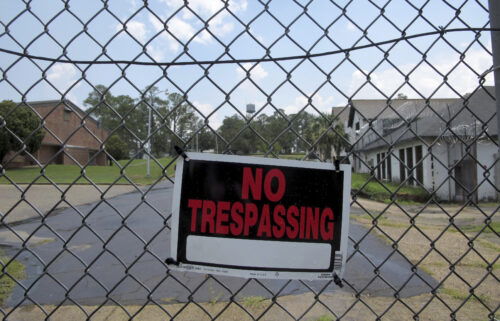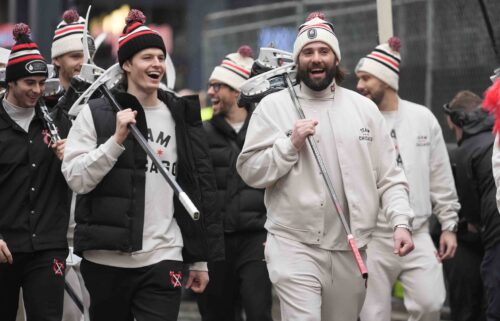Read about the ripple effects of a student project and the Lincoln boy who inspired it
By MARGARET REIST – Lincoln Journal Star, Neb. (TNS)
Accessible playground, 12.19
Lincoln Parks and Recreation Director Maggie Stuckey-Ross (from left), Alex Toalson and Brent Toalson pose for a portrait at the Antelope Park playground last week in Lincoln.
The first time Brent Toalson and Maggie Stuckey-Ross worked together, he was a teacher at Lincoln Southeast High School and she was a high school junior on student council.
Toalson was the student council sponsor — and a dad whose toddler had just been diagnosed with Duchenne muscular dystrophy, a progressive genetic disease where abnormal genes lead to muscle degeneration.
It was a lot to handle. Then he had an idea.
Alex, his blond-haired toddler with leg braces and a wheelchair, had taught him this much: The city didn’t have a decent playground for him. There was something called a “challenge playground” for children with disabilities, but it didn’t allow his son to play with other children. And it was always in disrepair.
His student council students, meanwhile, needed a project. Maybe, he thought, he’d found one.
Toalson called the city’s Parks and Recreation Department, and officials told him they were planning to renovate the Antelope Park playground. He asked if the students could help, maybe do something more. Parks and Recreation officials said yes, and the students jumped in.
They researched existing city parks and found what didn’t work for children with disabilities (most everything). They raised $25,000 and created flyers to educate the community, they delved into playground design and construction.
Brent Toalson
Brent Toalson holds his sons, Alex, 4, (left) and Ben, 2, on the new playground equipment installed at Antelope Park in 2000. The all-inclusive playground equipment designed for children of all ages and abilities was Toalson’s dream, which became a reality when the Southeast High School Student Council, which Toalson sponsored, took on the project.
The result: A state-of-the-art accessible playground in Antelope Park dedicated on a sunny day in 2000, the only one of its kind in the region and a place for Alex and other children to play.
The idea had, for Toalson, been a way to make sense of what was happening with his family, to give purpose to a deep-seated desire to help his child.
“We have a newborn, and we’ve got Alex and we’re just trying to juggle all of that,” he said. “Having this project with everything going on just became a way to turn some of those struggles that you have as a parent into something positive.”
The result impacted the whole city. The playground made the cover of a playground equipment magazine, and other cities wanted to follow suit.
Then the ripples kept spreading.
***
Stuckey-Ross graduated from Southeast in 2001, then attended Boston University before transferring back to the University of Nebraska-Lincoln and graduating with degrees in history and political science (same as her favorite teacher and student council sponsor).
She worked for Chuck Hagel, when he was a U.S. senator, then came back to Nebraska and got into fundraising for the Arbor Day Foundation and the University of Nebraska.
Then another job opportunity arose: director of the Lincoln Parks Foundation — a place whose mission and purpose had taught her so much during her time on student council.
Again, she jumped, taking the opportunity to lead the foundation that had helped raise money for the Antelope Park playground project years ago.
In May 2022, she took over as director of the city Parks and Recreation department.
Accessible playground
Lincoln Parks and Recreation Director Maggie Stuckey-Ross (from left), Alex Toalson and Brent Toalson at the Mahoney Park inclusive playground dedication in October.
And on a windy day in October, she found herself at another groundbreaking ceremony with her former teacher and his son — now a 29-year-old man with a biology degree who has beaten the odds of survival for many with his disease.
They were at Mahoney Park to celebrate what will become the city’s first all-inclusive playground, spearheaded by a group of parents advocating for a new generation of play equipment that goes beyond the accessible playgrounds of a quarter-century ago.
The next project will be a second all-inclusive playground — a redesign of the one Toalson and his students helped create in Antelope Park.
The groundbreaking was a reminder of what they’d done, and a symbol of what was to come.
“The realization that all these years later, we’d put something in motion that’s really important to the community; and the fact that other folks in town were willing to take up that banner of inclusive play,” he said.
“It felt good.”
***
A young Alex spent a lot of time with Toalson’s students while they worked on the playground project, and so did his mom and younger brother. A sort of family affair, Stuckey-Ross remembers.
“It was really powerful,” she said. “I mean, we knew Alex well and it was right in front of us that (the playgrounds) were going to be a barrier for him.”
That’s important, Toalson said, to be able to see things from a different perspective.
“They were able to see through their eyes some of the obstacles that able-bodied people just never think about, and that is a very powerful lesson if you’re a high school student.”
Toalson was determined that his students should be an integral part of the planning of the playground, not sitting on the sidelines, and Parks and Recreation officials let them.
They went to design meetings, met with marketing agencies, made presentations about the project to community groups and experimented with playground design using the school’s computer-aided design software.
Accessible playground
Alex Toalson (left) and Brent Toalson at the groundbreaking of the Antelope Park accessible playground 25 years ago.
One of the biggest lessons: the power of advocacy, of doing something for others, not yourself. That’s stuck with Stuckey-Ross.
“I think back to the time of working with Brent … and the eye-opening experience for me that you can challenge the status quo and do things and make things better for others,” she said.
The experience 25 years ago was eye-opening to Parks and Recreation officials, too, she said, who began to understand the importance of accessibility and inclusivity.
Years later, when a group of parents began advocating for a modern-day inclusive playground at Mahoney Park, that lesson informed how department officials approached the idea, and they concluded new inclusive spaces shouldn’t be limited by geography.
They came up with a long-range plan to make large inclusive playgrounds in the city’s four geographic areas and put accessible equipment in smaller parks.
“The legacy continues today,” Stuckey-Ross said. “It set the bar that we’re still reaching for and hopefully exceeding with this next chapter.”
***
A young Alex Toalson loved the swing the most.
He remembers his parents helping him go down the slide at Antelope Park, playing with sand on tables in the sand castle (an area designed with a nod to the Southeast Knights).
“I have good memories of going to the playground with my friends,” he said.
When he got older, he gave tours of the playground to groups, explaining all the accessible features.
Now, he wants to be a part of reimagining Antelope Park’s playground where he spent so much time.
Alex Toalson
A young Alex Toalson looks at a plaque at Antelope Park, where the city dedicated its first accessible playground in 2000.
“I want to learn about the inclusive play features that have been developed over the past 25 years,” he said.
He’s hoping once the playground at Mahoney opens he can try out its play features and make recommendations for Antelope Park’s inclusive playground. He wants to be part of the design process.
“I am excited about whatever I can do to help.”
Parks and Recreation officials have applied for a $600,000 federal grant, and Stuckey-Ross said they’ll start fundraising sometime next year.
Like his son, Toalson is on board, too, and he’d like to reach out to some of the funders who supported their efforts 25 years ago. And he’s already touched base with Lincoln High and Southeast principals about getting students involved — a service learning project for a new generation.
Who knows, he said, there might be another city director in the mix, maybe a mayor.
“That’s what it’s all about,” he said. “I mean, the project’s great, but it becomes a vehicle for teaching those lessons.”
And nobody’s taught him more than the blond-haired boy who loved to swing.
“None of this stuff would have happened if it weren’t for Alex,” Toalson said. “He really inspired a lot of us to go the extra mile.”
Watch our easy guide to using the E-edition
The E-edition is available to you every morning, and is updated throughout the day
Top Journal Star photos for December 2024
(c)2024 Lincoln Journal Star, Neb.
Visit Lincoln Journal Star, Neb. at www.journalstar.com
Distributed by Tribune Content Agency, LLC.


